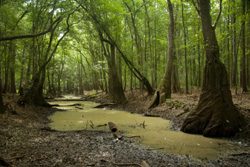Climate change data emerges from the mire
The appropriately named project, Abrupt climate changes over the European land mass (ACCROTELM) has collected valuable proxy-climate data. This is whereby one physical measurement can be used as an indicator of another. The project has extracted biomarker information from present bog-forming vegetation and compared it with data going back as far as 3,000 years. Deriving this information is possible due to the unique structure of the peat bog. The upper layer is peat forming and relates to recent changes. The layer below the water table however contains clues to long proxy-climate records. The period under study by project partners based at the University of Bristol included the climate change witnessed from the Medieval Warm Period to the Little Ice Age. This brief cold spell of about two centuries froze whole rivers across northern Europe and is thought to have ended in the early 19th century. Peat bogs from Ireland, UK, Germany and Finland were studied. About 400 peat samples were taken and analysed by gas chromatography and or mass spectroscopy (GC/MS). Residues extracted with lipids were characterised by pyrolysis-GC/MS which generates smaller, more volatile compounds that can be analysed easily using GC/MS. Identification of new and established biomarkers using these methods of analysis enabled the determination of changes in the macrofossil proxy. Even with anaerobic conditions prevalent in such a hostile environment to most microbes, decay occurs. Therefore, the presence of certain macrofossils could be determined by proxy where they were scarce or decayed. Another line of research involved hopanes. These are carbon-based molecules associated with making prokaryotic plasma membranes more fluid and are reliable bio-indicators of the presence of certain bacteria. Using compound specific stable isotope investigations, parts per thousand of the 13C isotope were measured (d13C) and hopanoid biomarkers were identified. Furthermore, the differences (dD values) in 13C isotope between samples in other bogs could then be obtained. The Bristol Biogeochemistry research centre at the university is continuing this line of research. They have published the accrued geochemical data as temperature signals from bogs, a reflection of changing climate. The biomarkers are also an indication of change in vegetation and chemical environment of the mires. Interested parties can avail of information on the ACCROTELM project on the website http://www2.glos.ac.uk/accrotelm/(opens in new window)







